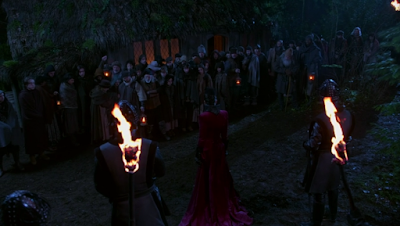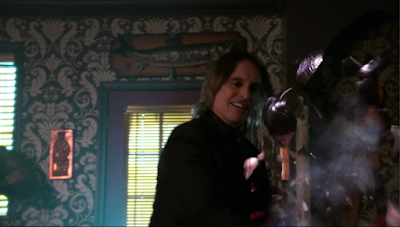It's been a while, and we'll be getting back to regular posting soon. In the meantime, we have another answer to the Society's most recent call for contributions--which is still open; we'd still love to hear from you! This one comes from Matt Tyler, who says of himself "Experienced hobbyist, Matt dabbles in roleplaying games, board games, war games, writing, and playtesting. He considers himself a novice in many of them, and a master of none."
The text of the post below is provided by Tyler, who reflects on his experience and understanding of heraldic practice as it relates to gaming. Included images are those Tyler recommends, attested and used in accordance with Fair Use. Other editorial adjustment is kept to a minimum and is made without comment.
ℜoderick stared in disbelief as the forces of the High Marshal rallied against the charge. Lines that had been crumbling were now pushing back on the blood-soaked field. Soon, Roderick knew, he would have to signal for the retreat or lose everything. Though, after this catastrophic turn of events, the Iron Dane might still take his head.
But how? It had been a gamble, to be sure, but only a slight one, and no word from his agents within the High Marshals ranks intimated a knight on this flank capable of such a feat of arms.
Roderick “The Blood Hawk” Marleybone craned up in his saddle, his black tabard stretched across the armor beneath, the three golden arches on the black field displayed for the world to see. His eyes strained to take in the scene of battle. The livery of the knights who opposed him swayed back and forth, glimpsed through the glinting forms of his own forces.
No. It can’t be.
His eyes squinted against the dance of color in the midday sun, straining to confirm what he hoped was a trick of the mind. No, there! It was! A hint of sky blue on the shield of the knight leading the counterattack. With a nod to the officer mounted next to him, a relay of signals went up, and the Blood Hawks forces fell back in haste.
Impossible. The black wyvern on a field of light blue, but, that line was gone, by his own hand ended, not a decade since.
As Roderick wheeled his horse about, his mind swirled at the possibilities of seeing the Blackwater coat of arms again...
As a reader, you know next to nothing about either of the knights mentioned in the story, yet with the inclusion of heraldry for the mysterious Blackwater knight, you now begin to conjure images in your mind of not only what they are wearing, but pennants, horse livery, and servant tabards. The bleak field of battle and death begins to take on color and pageantry.
The Pageantry of Battle
What most recognise today when they hear the word “Heraldry” is the codified and registered forms made popular from the medieval period, still used to modern day for royalty, organizations, corporations, and geographical/political regions. This system has its own language and rules to govern its use. It’s through these regulations that historians can solve ancient mysteries when discovering an ancient site of battle, or need to determine the ancestry of uncovered remains based on heraldic evidence.
It’s believed by many that the system of heraldry as it’s understood today was introduced from mainland Europe, but given its necessity on the fields of battle of the time, it quickly grew into something more. Used in tournaments, land grants, inheritance law, if one had a registered label of heraldry, it could prove an invaluable tool in many facets of medieval life. It evolved with the owner, becoming more complex with not only each deed given honor for, but marriages, and successive generations of the family line. In an age with no real forms of identification, those with the means and honors to acquire such an important piece of recognition were viewed in an altogether different light.
 |
| From Kawanakajima no kassen at the Library of Congress |
Heraldry Design
Arms of King Henry IV, differenced by a bordure argent. That’s the heraldic description for the coat of arms used by Humphrey of Lancaster,1st Duke of Gloucester.
 |
| A shot from Branagh's Henry V |
You’ll naturally be curious why some terms are used instead of others, and that has to do with the nature of the system being adopted widely from that of mainland Europe. Argent is the French word for silver, though in heraldry silver and white are used interchangeably. Which brings us neatly to the notion of color use in heraldry.
 |
| The Maryland state flag |
The inclusion of symbols is another major part of the craft, and it’s the combination of the two forms, color and symbols, and the combination with which they are combined, that one can convey a great amount of information with but the glimpse of an image.
Most anything can be used for the imagery it conveys. Animals and beasts both natural and mythical (birds, fish, bears), but also objects natural, mythical, and constructed (towers, swords, the sun, the Green Man). Many of these have been assigned meaning over the years, but like with most any language, those meanings will change over time and should not be seen as writ in stone. Horses in heraldry would typically be seen as “one ready for battle”, but there’s nothing to say it couldn’t be used for a messenger, or perhaps a noble lineage of scholars bearing the name Palfrey or Paulfrie.
In the opening narrative, we see arches used on Roderick’s tabard, which typically convey the position of a governor or magistrate. In this small way, if your reader takes it upon themself to investigate that aspect, you have given them a clue they can use to unravel your narrative without ever having to spell it out. This further brings them into your setting.
When I Left You, I Was But the Learner
Knowing even the most basic of information on the subject is usually enough to begin working on your own setting specific heraldry with rules or guidelines. Even in the lands of Middle-earth, Tolkien created a sense of heraldic arms for various houses and factions. The most recognizable being Aragorn's royal standard, unfurled on the fields of battle towards the end of the trilogy, though in the movies more basic versions of the Gondorian crest can be seen on the shields of the guards, and indeed in the helmet designs.
In writing fiction, we have a great tool to use here with the use of color and imagery to convey much about our characters and our setting. With the change of colour we shift preconceptions from one to another. In western movies the good characters wore white and the villains wore black. If a coat of arms is seen to have a dark motif, one might naturally assume villainous intent.
In running games, we have a way for our players to personalize the world. Guilds need emblems and crests, warriors need coats of arms, and kingdoms founded need banners. Some simple tracing paper, a laptop to get images from, and then an inexpensive drawing pad can allow players to make up their own heraldry to bring the world to life and leave their mark. Imagine some players leave and new ones arrive, tales of the Knight of Bonded Grove catch their interest and all they have to go on is a white stag rearing inside a golden wreath of ivy on a green field.
In playing wargames, we have a system to easily allow us to achieve wonderful color schemes for our armies. Using the basic rule of no color on color, or metal on metal, one can begin to devise a striking scheme for their troops that will draw the eye on the battlefield. Are your space warriors covered in variations of tan and green, or perhaps yellow and black, or maybe even orange and blue? Try using metallic paints to break up the colors you wish to use, say a shoulder pad or shield with black and silver trim to stand out from the blood-red armor.
Resources
I have been fortunate enough in my meager investigation of heraldry to exist in a time where the internet has made such searches easily accomplished. As one who dabbles in all aspects of the hobbies naturally drawn to a gamer, I have also encountered numerous sources from personal, individual communication. My favorite resources I’ll list here, though numerous stores of information are easily accessible with the click of a button.
- 1. Re-enactment. I live in an area where historical reenactment takes on several forms and is richly done. One major organization is known as the SCA (Society for Creative Anachronism). In these made-up kingdoms, the rules of historical use are as closely followed as possible, including preparing the same meals at events as would be made in medieval times. Among the many aspects of the system, those who wish to take on the role of a herald must apply themselves to the role as diligently as any would have done historically, including sometimes learning multiple languages and being fluent in the rules of heraldry and coats of arms. Just as colleges of heralds have enlisted throughout history, these reenactment scholars likewise preserve their worlds history and culture through heraldic knowledge and can be a wealth of personal experience to draw from.
- The Complete Book of Heraldry by Stephen Slater. A Beautiful book that can be found relatively on the inexpensive side of things. It covers the history and nature of heraldry in detail, though it doesn’t provide all the symbols and meanings one would need to generate historically accurate heraldry. The heart of the book is to provide a deep understanding of the system itself from its inception through to modern era usage.
- Modern History TV on YouTube. A fun channel that delves into rediscovering what life was like in the medieval period from the foods eaten through to travel times. Heraldry is touched on, but recommending more as a good resource for the setting and making it believable in roleplaying games, novels, or paintings.
- The Dictionary of Heraldry by Joseph Foster.
- An Encyclopedic Dictionary of Heraldry by Julian Franklyn.























